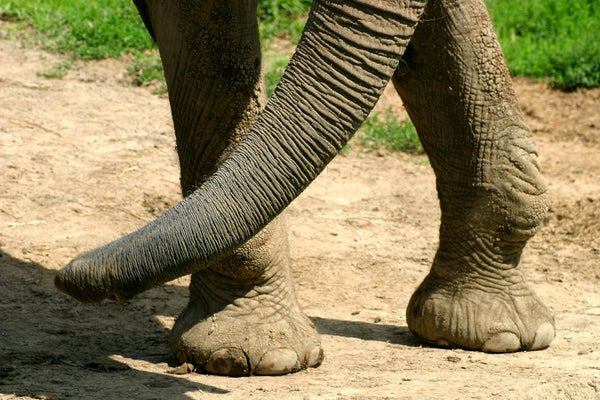This article was published in Scientific American’s former blog network and reflects the views of the author, not necessarily those of Scientific American
When you weigh upwards of 6,000 kilograms, you tend to leave a trace of yourself wherever you walk. That’s definitely the case with African elephants (Loxodonta africana), which, according to new research, is actually a boon for dozens of other, much tinier, species.
As discussed in a paper published this week in the African Journal of Ecology, elephant feet play an important ecological role in Uganda, and probably in other countries. As elephants walk through the forest, they leave deep footprints behind them. These footprints then fill up with water, creating little foot-shaped microhabitats for at least 61 different microinvertebrate species from nine different orders.
Among those living in Footprint Land were species of mites, mayflies, backswimmers, leeches and gastropods. They also found a large number of tadpoles.
On supporting science journalism
If you're enjoying this article, consider supporting our award-winning journalism by subscribing. By purchasing a subscription you are helping to ensure the future of impactful stories about the discoveries and ideas shaping our world today.
None of this has been observed before, although some previous research has linked elephant footprints to mosquito breeding sites, according to the paper.
The researchers, from Germany’s University of Koblenz-Landau and other institutions, did more than just discover this microinvertebrate community. They wanted to know just how much the tiny denizens relied on these elephant footprints. They measured the age of each footprint, as well as the temperature and pH of the water inside, as well as its distance to other footprints and natural bodies of water. They also created a series of artificial elephant footprints in order to test things even further.
All told, they found that the oldest footprints held the highest levels of biodiversity due to the added level of dead leaves that had fallen into the prints, as well as new vegetation that had started to grow. The oldest prints were also the only ones that contained tadpoles. Meanwhile, the medium-aged prints had the lowest biodiversity levels.
The authors acknowledge that this is a preliminary study and that more work needs to be done in order to understand just how the elephant’s foot plays into the broader ecosystem, but they write that this appears to be an important part of the lifecycle and food web for many species. They especially call out amphibians, as larger invertebrates could eat tadpoles while adult frogs could eat the other invertebrates.
As I’ve written before, elephants are important seed dispersers and have numerous other vital roles in their ecosystems. This new research just adds to that knowledge, and serves as one more reminder of what we can lose if the ongoing poaching crisis affecting Africa’s elephants continues to eliminate these essential animals from their habitats.
Previously in Extinction Countdown:
